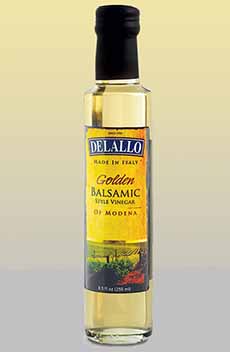RECIPE: Italian-Style Tuna Salad With Chickpeas
|
|
You can always count on a can of tuna for a protein-packed salad. But you can add even more protein by mixing in some chickpeas (a.k.a. ceci bean [Italian], garbanzo [Spanish] and other names*). This tuna salad recipe from Delallo is Italian-style: an olive oil and balsamic vinaigrette instead of mayonnaise (photo #1). That means no mayo to spoil in the heat, making the recipe a great patio and picnic food. Have it for lunch, or as a first course for dinner. And definitely make some garlic bread, on the grill or under the broiler. You can also turn a hero-style roll into garlic bread and enjoy the salad as a sandwich. Yum! While Italian canned tuna is more flavorful than American brands, it is also costlier. So use whatever you have on hand; and when you’re ready for a splurge, treat yourself to an Italian brand. Most are so delicious, they can be eaten right on a bed of salad or crostini with no additional ingredients. Ingredients For 6 Servings 1. WHISK together olive oil, vinegar, lemon zest, salt and pepper in a large serving bowl. 2. ADD in the chickpeas, peppers, onion, tuna and basil. Toss well to combine. 3. CHILL for at least 1 hour to let the flavors meld. Serve over mixed greens. |
|
|
GOLDEN (WHITE) BALSAMIC & TRADITIONAL BALSAMIC VINEGAR: THE DIFFERENCE Traditional balsamic vinegar is a dark and slightly sweet, syrupy vinegar (here’s more about it). The authentic balsamics come from the Emilia-Romagna region of Italy, and can be aged for 12 to 150 years. They are pricey, abut worth it to ardent fans. The older the bottle, the costlier. A 12-year-old bottle on the shelf can be $40 or more; the balsamics over 75 years old can cost hundreds of dollars. That’s because the older balsamics, which more intense and more syrupy/concentrated, get so by evaporating over time. There is a longer holding cost and less vinegar to sell after years of evaporation. Not surprisingly, counterfeit balsamics abound. Here’s the scoop on fake balsamic vinegar. Supermarket balsamics that cost $5-$10 a bottle are simply regular wine vinegar, colored a deep dark brown with caramel. They’re not magnificent like authentic balsamic, but can be fine for salad dressings. The one problem with dark balsamic vinegar is that, whether in a dressing or a sauce, it can turn light-colored ingredients—like fish, chicken breasts and white cheeses like feta—brownish. Thus, golden balsamic vinegar was born. It’s also called white balsamic. Golden balsamic vinegar originates from the same region of Italy as traditional balsamic vinegar. Instead of being made like authentic balsamic from a mandated assortment of local grapes—the mandated grapes in traditional balsamic are Ancellotta, Berzemino, Lambrusco, Occhio di Gatta, Sauvignon, Sgavetta and Trebbiano, all grown in the Reggio Emilia region—golden balsamic is made only from Trebbiano grapes. It is cooked for many hours into a caramelized syrup, which is then aged to create the vinegar. |
||
|
Instead of aging the vinegar for 12 or more years, golden balsamic is put in oak barrels or stainless steel for only one year. The result is sweeter and simpler than traditional balsamic, but welcome when you don’t want your light ingredients to take on color—or when you want a naturally sweet vinegar for drizzles, fruit salads and other dishes. ________________ *Additional names for chickpeas include Bengal gram in Tamil, India; chana in Hindi and Urdu, India; Sanagalu in Telegu, India; hummus in Arabic; kabuli in Afghanistan; and Egyptian pea. |
||




